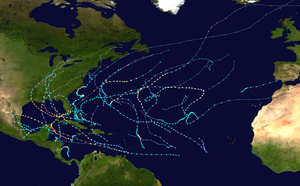
Back موسم أعاصير المحيط الأطلسي 2005 Arabic Temporada d'huracans de l'Atlàntic de 2005 Catalan Den atlantiske orkansæson 2005 Danish Atlantische Hurrikansaison 2005 German Temporada de huracanes en el Atlántico de 2005 Spanish فصل توفند ۲۰۰۵ (میلادی) اقیانوس اطلس FA Vuoden 2005 Atlantin hurrikaanikausi Finnish Saison cyclonique 2005 dans l'océan Atlantique nord French עונת ההוריקנים האטלנטית 2005 HE Stagione degli uragani atlantici del 2005 Italian
| 2005 Atlantic hurricane season | |
|---|---|
 Season summary map | |
| Seasonal boundaries | |
| First system formed | June 8, 2005 |
| Last system dissipated | January 6, 2006 (record latest, tied with 1954) |
| Strongest storm | |
| Name | Wilma (Most intense hurricane in the Atlantic basin) |
| • Maximum winds | 185 mph (295 km/h) (1-minute sustained) |
| • Lowest pressure | 882 mbar (hPa; 26.05 inHg) |
| Seasonal statistics | |
| Total depressions | 31 (record high, tied with 2020) |
| Total storms | 28 |
| Hurricanes | 15 (record high) |
| Major hurricanes (Cat. 3+) | 7 (record high, tied with 2020) |
| Total fatalities | 3,468 total |
| Total damage | $172.297 billion (2005 USD) (Second-costliest tropical cyclone season on record) |
| Related articles | |
The 2005 Atlantic hurricane season was the most active year on record until surpassed by 2020. It featured 28[1] tropical or subtropical storms. The United States National Hurricane Center[nb 1] named 27 storms, exhausting the annual pre-designated list, requiring the use of six Greek letter names, and adding an additional unnamed storm during a post-season re-analysis. A record 15 storms attained hurricane status, with maximum sustained winds of at least 74 miles per hour (119 km/h). Of those, a record seven became major hurricanes, rated Category 3 or higher on the Saffir–Simpson scale. Four storms of this season became Category 5 hurricanes, the highest ranking.
The four Category 5 hurricanes during the season were: Emily, Katrina, Rita, and Wilma. In July, Emily reached peak intensity in the Caribbean Sea, becoming the first Category 5 hurricane of the season, later weakening and striking Mexico twice. In August, Katrina reached peak winds in the Gulf of Mexico but weakened by the time it struck the U.S. states of Louisiana and Mississippi. The most devastating effects of the season were felt on the Gulf Coast of the United States, where Katrina's storm surge crippled New Orleans, Louisiana, for weeks and devastated the Mississippi coastline. Katrina became the costliest U.S. hurricane, leaving $125 billion in damage[nb 2] and 1,392 deaths. Rita followed in September, reaching peak intensity in the Gulf of Mexico before weakening and hitting near the border of Texas and Louisiana. The season's strongest hurricane, Wilma, became the most intense Atlantic hurricane on record, as measured by barometric pressure. Lasting for ten days in October, Wilma moved over Cozumel, the Yucatán Peninsula, and Florida, causing over $22 billion in damage and 52 deaths.
The season's impact was widespread and catastrophic. Its storms caused an estimated 3,468 deaths and approximately $172.3 billion in damage. It was the costliest season on record at the time, until its record was surpassed 12 years later. It also produced the second-highest accumulated cyclone energy (ACE) in the Atlantic basin, surpassed only by the 1933 season. The season officially began on June 1, 2005, and the first storm – Arlene – developed on June 8. Hurricane Dennis in July inflicted heavy damage to Cuba. Hurricane Stan in October was part of a broader weather system that killed 1,668 people and caused $3.96 billion in damage to eastern Mexico and Central America, with Guatemala hit the hardest. The final storm – Zeta – formed in late December and lasted until January 6, 2006.
- ^ Miller, Susan. "Tropical Storm Eta expected to intensify into the season's 12th hurricane on Monday". usatoday.com. USA Today. Archived from the original on November 1, 2020. Retrieved November 1, 2020.
Eta is the 28th named storm of a historic season, which has tied 2005 for most storms on record. It has been since 1969.
- ^ Worldwide Tropical Cyclone Centers (Report). National Hurricane Center. September 11, 2011. Archived from the original on March 21, 2015. Retrieved March 19, 2020.
Cite error: There are <ref group=nb> tags on this page, but the references will not show without a {{reflist|group=nb}} template (see the help page).